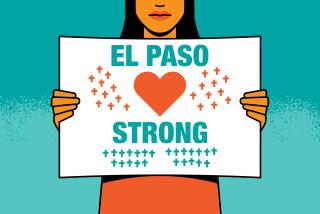Unwelcome Change : Renaming of El Toro Angers Feisty Descendant of Don Given Land in Mexican Grant
- Share via
TRABUCO CANYON — The Persian Gulf War came and went and Reyes Serrano didn’t hear a word about it.
He also did not hear the news that greater El Toro will soon be known as the city of Lake Forest. He squirts tobacco juice into a plastic cup and begins to swear when a visitor tells him about the change.
“It makes me want to take my gun and go up there and make them change it right back to El Toro,” says Serrano, a great-grandson of Don Jose Serrano, who received the original Mexican land grant of 10,000 acres of land that became El Toro.
Dora Serrano, his wife of 61 years, is even more angry.
“You mean they actually did that?” asks Dora Serrano, 78, with a painful expression on her wrinkled face. “It’s these damn city people that come to our country and make a city and change the name. Dammit!”
For the Serranos, the name change is a modernity they cannot quite comprehend. But like other changes they have witnessed during the past decades, they doubt this one will faze them for long.
At 90, Reyes Serrano is revered by local historians as California’s oldest vaquero (cowboy). He and Dora Serrano live in a trailer home in Trabuco Canyon in one of the last remaining rural areas of Orange County.
Ironically, the trailer home is a stone’s throw away from suburbia--the tract homes and condominiums in Rancho Santa Margarita.
Surrounded by oak and sycamore trees, the Serranos live as if the nearby developments never existed. Here, there is no homeowners’ association to complain about the old wagon wheels, rusting tools and bird coops in the front yard where the Serranos keep an old white horse, Lady, four dogs, nine ring-necked doves, a parakeet and a peacock.
Reyes Serrano is a living icon of Southern California’s rancho history. His great-great-grandfather, Don Francisco Serrano, served as chief executive officer of the pueblo of Los Angeles in 1799. Don Francisco’s son, Don Jose Serrano, was granted the El Toro land in 1846 as part of a sweeping series of land grants in Orange County.
Reyes and Dora Serrano said that for years the Serrano family borrowed money at exorbitant interest rates and had to sign over the land to Banker Slauson of Los Angeles following the devastating drought of 1863-64.
But the family stayed in the community and “became integral parts of the El Toro scene, never complaining about their ill fortune or bad breaks, simply going to work and doing the best job they could,” writes Whittier teacher Joe Osterman in his book, “Stories of Saddleback Valley.”
Reyes Serrano, for example, is a former hand on the Irvine, Mission Viejo and Moulton ranches. Known for his feisty character, he earned a reputation for being Southern California’s most rugged cowboy.
After retiring from the Irvine Ranch in 1967, he bought some cattle and moved his other livestock to a 102-acre Trabuco Canyon spread owned by Ann Robinson. In 1981, the Serranos had to move out after the land was sold to developers.
Property owner Leonard Schwendeman, however, came to the couple’s rescue, offering them a 40-acre plot under the snowcapped Trabuco Peak on the condition that they serve as caretakers.
But two years later, disaster struck. A fire razed their trailer, destroying Reyes Serrano’s prized saddles, guns and other equipment.
For Dora Serrano, the loss was even more devastating. For years, she had saved money by selling beer cans to buy books about the region’s history. She had spent years researching the Serrano family through old clippings, church records and family stories and had hoped to put together a book of her own. Much of the material was lost in the fire.
Included in the book would have been Dora Serrano’s version about how El Toro really got its name.
One version suggests that the community was named El Toro after a padre’s prayer for divine intervention stopped a charging bull. Another claims that the community was named after the family’s bellowing bulls.
But Dora Serrano says El Toro was named after a white-faced prized bull owned by her husband’s grandfather, Francisco Serrano, that was found at the bottom of a well.
Dora Serrano’s hopes went up in the flames. “It hurts me when I think how everything, all the history, burned in that fire,” she says, her voice breaking. “It’s so painful.”
The Serranos owned a few head of cattle up until three years ago. But Reyes Serrano broke a leg and suffered a slight stroke when he attempted to deliver a calf. Dora Serrano decided to sell the herd and set aside the money for her husband’s funeral.
For now, they say, they will stay put--watching the development and changes around them but with a historical perspective few others share.
More to Read
Sign up for Essential California
The most important California stories and recommendations in your inbox every morning.
You may occasionally receive promotional content from the Los Angeles Times.













